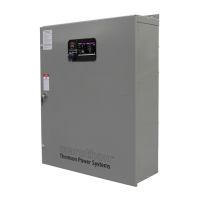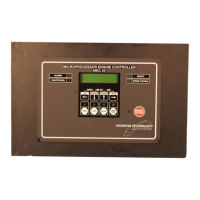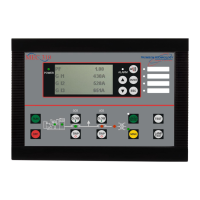the transfer switch sources reach an in-sync condition, the Transfer Fail logic will be
initiated. Select desired time in seconds.
5.16.2. EXTERNAL SYNC CHECK WAIT DELAY
When the ATS is ordered with a Closed Transition option (i.e. ATS Model Code Digit #13
“Operation Type” 3 or 4), and an external synchronizer is supplied, a sync check wait
delay time feature is available. When the Fail to Sync alarm feature is enabled (refer to
Section 5.11.15), this timer is programmed to allow the desired amount of time for the
auto synchronizing process to occur. If the External Sync Check wait delay expires, an
alarm will be posted and the ATS will either halt or continue auto synchronizing operation
based on the setting of option feature “HALT TRANSFER ON FAIL TO AUTO SYNC”
refer to Section 5.11.16 for programming information.
5.16.3. FAIL TO UNLOAD TIMER (CTTS MODEL 4)
When the ATS is ordered with a Closed Transition soft-load option (i.e. ATS Model Code
Digit #13 “Operation Type” 4), a fail to unload alarm time delay feature is available. When
the Fail to Unload alarm feature is enabled (refer to Section 5.11.19), this timer is
programmed to allow the desired amount of time for a normal soft-unload process to
occur following a closed transition transfer operation. Should the pre-programmed time
expire before the source “unloaded” confirmation digital input signals are received
transfer during a closed transition, an alarm will be posted. The alarm will also activate
the common TSC 900 "Transfer Fail" alarm output.
5.16.4. CLOSED TRANSITION MAX OVERLAP TIMER
For Closed Transition Transfer applications, the TSC 900 transfer controller includes an
adjustable time delay for the maximum allowable time the 2 sources can be connected
in parallel. If this time delay is exceeded, one of the pre-selected source power switching
devices will be automatically tripped open. In soft-load applications, this time delay is
bypassed. Set to the desired time in seconds.
5.16.5. SOURCE FREQUENCY DIFFERENTIAL HIGHER THRESHOLD
Set to the desired source frequency differential higher set point as expressed in
percentage of nominal system frequency. An in-sync transfer operation will be blocked
if the measured difference between both source frequencies reaches a higher threshold
value than specified.
